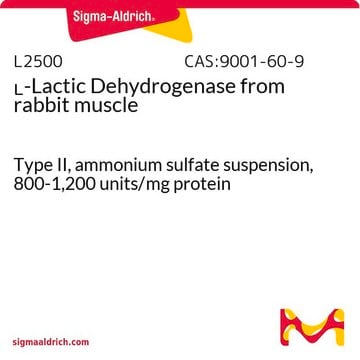P7252
Phospho(enol)pyruvic acid tri(cyclohexylammonium) salt
≥98% (enzymatic), powder
Synonym(s):
2-(Phosphonooxy)-2-propenoic acid tri(cyclohexylammonium) salt, PEP-3CHA, Phosphoenolpyruvic acid tris(cyclohexylamine) salt
About This Item
Recommended Products
product name
Phospho(enol)pyruvic acid tri(cyclohexylammonium) salt, ≥98% (enzymatic)
Assay
≥98% (enzymatic)
form
powder
solubility
water: 100 mg/mL, clear to very slightly hazy, colorless to faintly yellow
storage temp.
−20°C
SMILES string
NC1CCCCC1.NC2CCCCC2.NC3CCCCC3.OC(=O)C(=C)OP(O)(O)=O
InChI
1S/3C6H13N.C3H5O6P/c3*7-6-4-2-1-3-5-6;1-2(3(4)5)9-10(6,7)8/h3*6H,1-5,7H2;1H2,(H,4,5)(H2,6,7,8)
InChI key
MJKYGUXBFYGLLM-UHFFFAOYSA-N
Looking for similar products? Visit Product Comparison Guide
General description
Application
- in the pyruvate kinase/lactate dehydrogenase enzyme kinetic assay
- in the reaction mixture to determine fructokinase activity of Zobellia galactanivorans
- in luminometry to determine the amount of ADP formed by measuring the increase in light output
Biochem/physiol Actions
Storage Class Code
11 - Combustible Solids
WGK
WGK 3
Flash Point(F)
Not applicable
Flash Point(C)
Not applicable
Personal Protective Equipment
Certificates of Analysis (COA)
Search for Certificates of Analysis (COA) by entering the products Lot/Batch Number. Lot and Batch Numbers can be found on a product’s label following the words ‘Lot’ or ‘Batch’.
Already Own This Product?
Find documentation for the products that you have recently purchased in the Document Library.
Customers Also Viewed
Our team of scientists has experience in all areas of research including Life Science, Material Science, Chemical Synthesis, Chromatography, Analytical and many others.
Contact Technical Service











